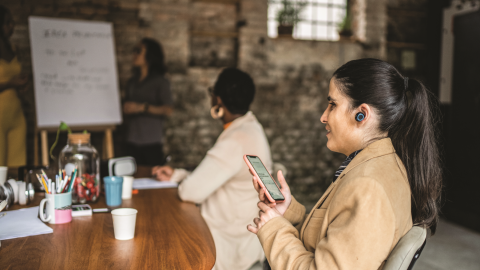Researcher Sees Accessibility Becoming an Integrated Part of Technology Design
Sara Hendren is a researcher and artist who works in the area of design, accessibility, adaptive and assistive technologies, prosthetics, and cultural and political representations of disability. The following blog post was written by Paul Nyhan, a staff writer with the Microsoft Accessibility Blog.
—–
Sara Hendren wants everyone to rethink assistive technology because she says all technology is essentially assistive.
When the artist and researcher looks at smartphones, laptops and tablets she sees how these tools assist users. She also doesn’t see the difference between those devices and what has traditionally been known as assistive technology designed for users with disabilities.
“Honestly — what technology are you using that’s not assistive? Your smartphone? Your eyeglasses? Headphones? And those three examples alone are assisting you in multiple registers: They’re enabling or augmenting a sensory experience, say, or providing navigational information,” Hendren wrote in a story for Medium.
In some ways, Hendren’s thinking mirrors Microsoft’s people-centric approach to technology that creates multiple ways for people to interact with computing devices and services. When developers built the Kinect platform for Xbox, for example, they created several ways for people to use the gaming system, through voice, gestures or controllers. This design made Xbox more inclusive by expanding the universe of users.
Hendren’s broad view of technology, though, extends far beyond gaming platforms. She suggests using ability and disability as starting points in design, not as issues to be addressed after a product is created.
We talked with Hendren about what she likes in current technology design, and what could be coming.
What technology designs have you seen from Microsoft and other companies that fit into your vision of what assistive technology could be?
I’m excited about the new tools for web accessibility that are coming to the fore now. The best designers are seeing that access doesn’t have to be about appendages to design; it can rather be a beautifully integrated part of how users experience the digital space.
I am also certainly watching 3D printing closely, like a lot of people. The capacity to make more lightweight, customized and dynamic prosthetic parts is really exciting. The “Magic Arms” project is one of my favorites in this field, as is the work of David Sengeh at MIT. These things are just the beginning.
For a long time I’ve been defending the open space of speculation and fiction in design, and especially the disposition of “critical design” as a productive interlocutor for research in assistive tech. That’s the work of artists and designers that isn’t geared toward manufacturability or even practical use; instead it’s devices and tools that ask questions: about what counts as normal or abnormal, able or disabled.
I’m pleased to see Microsoft working on multiple technologies around low vision and blindness for web users. There’s so much gradation in sight capacity that we need many different kinds of options, like the refreshable Braille display and responsive screen readers and options for text size and contrast. It’s that kind of multi-pronged approach that will make the web a meaningful interface for many more people. It’s also good to think about these developments as those addressing “print disabilities,” not just low vision. So for people who are dyslexic or have some other neuro-cognitive challenges in processing print, those options will also be meaningful.
What types of assistive designs would you like to see the tech sector work on this year?
I’d like to see the tech sector engage more artists and designers in helping them to check assumptions, connect with wider audiences, and creatively seek new ways to understand how all different kinds of people need and use all different kinds of devices. I want to see issues of equity and access be central — as a design challenge — to the conversations among the very best developers and thinkers. Using ability and disability as a beginning kind of organizing principle is a tremendously productive way to start to think more largely about technology and use and users in general, so I’d like to see the tech sector actively nurture young designers in training to think about age and ability and the changing body over the life span — from very early in their careers.
(This interview was condensed and edited.)
Read about Hendren’s approach on her Abler website and in her story, “All Technology Is Assistive Technology: Six dispositions for designers on disability,” in Medium.







